Max Allan Collins's Blog, page 26
March 9, 2021
John Sand at Wolfpack, Heller at Hard Case Crime
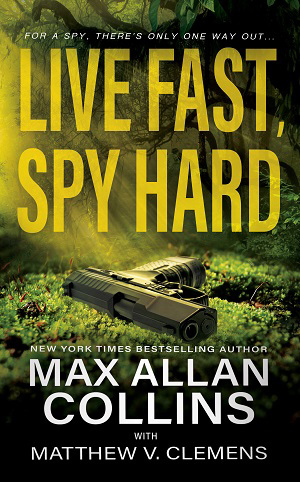
The second John Sand novel by Matt Clemens and me – Live Fast, Spy Hard – is out this month. The Kindle version is available for pre-order right now (for $3.99).
The Kindle pub date is March 17. The trade paperback edition should follow quickly, but I don’t have a date for that yet.
The cover is, in the opinion of the authors, a dandy. Wolfpack is coming up with some great covers for both new books of mine and for backlist titles. I remain astonished by how fast they move – this is a book Matt and I delivered this year. Traditional publishing takes a minimum of nine months from delivery to publication.
You can read this one without having read the first book in the series, Come Spy With Me, which of course is already available here.
Matt and I have already plotted the third book, To Live and Spy in Berlin, and Matt is working on the rough draft right now. I will be starting my draft next month. Whether we’ve written a trilogy or the first three books in a longer series depends on the response of readers, i.e., sales. But we are having an enormously good time writing these slightly tongue-in-cheek yarns about the “real-life” spy that just might be who Ian Fleming based his James Bond character on.
Wolfpack’s edition of Reincarnal has been corrected as to its messed-up table of contents, and the collection has been getting some lovely notices. Shoot the Moon has been well-received, too. Again, Wolfpack has done beautiful covers for the books, the former a new title, the latter a restructuring of the collection Early Crimes with the title novel of the new version brought forward to emphasize that it’s a novel with a couple of bonus short stories, and not a short story collection.
The Shoot the Moon book giveaway found the ten copies going lightning fast. Again, if you’ve received books in any of these giveaways, please remember the point of the exercise is to get some reviews on Amazon and elsewhere.
* * *More good news, at least for me and for Nate Heller fans. For some time, I’ve been kicking around the idea of doing Heller novels at Hard Case Crime. With Quarry, Nolan and a few other titles of mine at HCC, I’m their most published author, and I’ve built a nice readership there, some of which (I suspect) has not tried Heller, intimidated by the historical nature (and sometimes length) of the books. These readers don’t realize that Heller is very much in the mold of Quarry, Nolan, Mike Hammer and other characters of mine. I consider Heller my signature character, and he has been my most enduring creation with those novels bringing me the most critical acclaim.
Additionally, Road to Perdition – the graphic novel that remains my major claim to fame – is a spin-off of sorts of the Heller saga. It came about when an editor at DC asked for a graphic novel in the Heller vein, but with new characters.
I’ve long felt that the retro publishing style of HCC would be a perfect way to widen the Heller readership, and editor Charles Ardai agreees. The titles of the new Hellers – The Big Bundle and Too Many Bullets – will give them a decided HCC feel. Recently, when the Heller run at Forge ended after five books (Do No Harm the most recent), the opportunity to move to Hard Case became a reality. Parent company Titan has offered a two-book Heller contract at HCC, and I am very grateful to publisher Nick Landau and his crew (including my Mike Hammer editor, Andrew Sumner) for their belief in me and my work.
A two-book contract will allow me to complete the five-book Kennedy saga (and the two-book Robert Kennedy cycle), which may bring the series to an end. Heller began in 1983, and – having celebrated (or is that survived) my 73rd birthday last week – I am not sure the rigorous research required for a Heller is something I’ll be up to after this two-book contract is delivered (one book early next year, the other early the following year).
If I do feel up to going on with Heller after the Kennedy saga is complete (the other books are Bye Bye Baby, Target Lancer and Ask Not), that will depend upon the response, chiefly sales. Subjects I’m contemplating are the killing of Martin Luther King, the murder of George Reeves, and Watergate.
Do No Harm continues to get strong notices, including Jon Breen’s current write-up (complete with the cover on display) in Mystery Scene. If you haven’t read this one, a reminder: no mass market or trade paperback is scheduled, so you’ll have to spring for hardcover (or Kindle).
* * *The decision by the Dr. Seuss estate to pull half a dozen titles because of racist imagery is a smart move on their part, but a sad day for authors and, for that matter, readers.
Still, racism in a children’s book, however unintentional, makes those books, published long ago, problematic today. I get that. But I feel the best way to deal with this – in this current judgmental climate, at least – is to publish a disclaimer that, in a kids’ book, encourages parental guidance and discussion. That a gentle soul like Ted Geisel – who preached racial tolerance by way of parable through wonderful cartoons and fun absurd rhymes – faces this kind of thing is distressing if understandable.
TCM is going to great lengths to have discussions of classic films that have committed the sin of not being “woke” forty, fifty, sixty years ago. This is nothing new at TCM, who did the same for Charlie Chan movies quite a while back. Whether they are being socially responsible or playing a CYA game is in the mind of the beholder.
Disney and Warner’s, on their classic cartoon collections, have long had disclaimers, and my pal Leonard Maltin has delivered some of those (so has Whoopee Goldberg). Again, with kids I get this. But grown-ups actually shouldn’t need the disclaimers (although CYA does seem to require it), because anyone not standing on their IQ ought to have an awareness of when a film was made and at least a vague idea of the cultural context.
A stunted sense of humor and particularly lack of a sense of irony seems at play here. My generation, through underground comix and comedy of the SNL and SCTV variety, mocked racial and sexual stereotypes; humor, satire, is an excellent way to make such points, though trying to do so now would be perilous.
As usual, nuance has gone out the window. This may come as a shock to some, but the Mickey Rooney Asian bit in Breakfast at Tiffany’s was always offensive, and was found so at the time and ever since. But it reflected director Blake Edwards’s slapstick instincts and, again, is a spoofing of racism; it doesn’t work in Breakfast because it’s so over the top and unfunny, and is jarringly out of step with the otherwise sophisticated tone of the movie.
But I am sure we will see a move to ban the same director’s Pink Panther movies with the Inspector Clouseau/Cato relationship. Is there some way to explain that “my little yellow friend” was funny because it was so wrong, and we knew at the time that it was?
The danger of such self-righteous attitudes is that the work of ethnic artists – great actors like Burt Kwouk (Cato), Tim Moore (the Kingfish), and Mantan Moreland (Charlie Chan’s chauffeur) – may be lost to time, censored out of existence. I shudder to think that the Great American Novel (The Adventures of Huckleberry Finn) will be banned from even more bookshelves. Is John Ford’s film The Searchers any less a condemnation of racist hatred because a white actor in “redface” plays Scar, the antagonist chief? The answer might be yes, but I would suggest a more logical, fair answer would be, “It was made in 1956.”
This notion that intention is irrelevant is especially troubling. Of course intention isn’t an excuse or a free pass; but neither is it beside the point. Good intentions may pave the road to hell (aka perdition), but they are a sign of a teachable situation where, say, a KKK rally isn’t.
* * *Here’s a terrific review of Skim Deep.
Here’s a reprint of a Kill Your Darlings review by the knowledgeable Art Scott. It’s a Mallory novel.
And here’s an extensive look at my work (an expansion of a previous piece) at Atomic Junkshop.
M.A.C.
March 2, 2021
Shoot the Moon & A Shot in the Arm
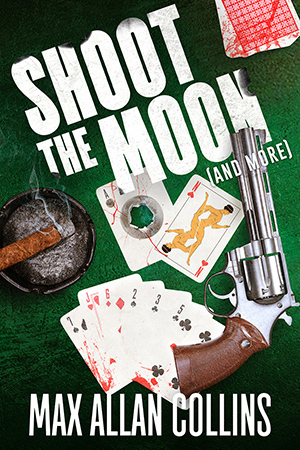
E-Book:

Trade Paperback:





Yes, it’s one of our ever-popular book giveaways. I have ten copies to give to the first ten readers who request it and agree to do an Amazon (and/or other) review. Those of you who have won books in the past and have not posted a review yet, for shame. Those of you who have won books and hated the book and haven’t posted a review, thank you.
[All copies for the giveaway have been claimed. Thank you for your support! –Nate]
Anyway, this is for Shoot the Moon, which is a repackaging (with revised intro) of Early Crimes. I’ve done this because Shoot the Moon is a novel and Early Crimes was rather inaccurately described as a collection. What we have is a novel, written about six books into my career, that was my attempt to do a Donald E. Westlake-style comedy of crime. By now you can see that Westlake was a major influence on my work, and was in fact a mentor to me when I was working on Bait Money, the first published Nolan novel, which of course was written as a pastiche/homage to Westlake’s Richard Stark-bylined Parker novels.
So perhaps it was natural that I try to follow in his other footsteps, and Shoot the Moon is that novel. It’s a short novel (but not a novella) and the two early short stories, “Public Servant” and “The Love Rack,” follow the novel as the equivalent of DVD/Blu-ray bonus features.
Back to the book giveaway. Write me at [link removed], and (this is important) include your snail mail address, even if you’ve won before. This is for USA only. That’s not patriotism, it’s cheapness (foreign postage is particularly high in the Covid era).
Speaking of which….
Barb and I have received our first vaccine doses (the Pfizer variety) and we are greatly relieved. How we got it is reflective of the difficulties even those of us who are seniors with underlying conditions are having getting vaccinated for Covid-19. Here’s our story.
For about a month I have been haunting the site of the Hy-Vee supermarket’s pharmacy (Hy-Vee being the major grocery chain in Iowa). It’s where Barb and I step outside of sheltering in place to take in “geezer” hour and do our weekly grocery shopping. The benefits are fewer people and ‘60s-era oldies playing instead of country western.
About four trips to Hy-Vee ago, I stopped at the pharmacy window to ask how I went about getting an appointment for vaccination. I was told by the pleasant young woman to sign up on-line and I would receive updates. (To date, I have received none. I also enrolled at Walgreens and also got zip updates.) On my next trip to the Hy-Vee pharmacy I inquired about when a vaccine shipment might be coming in and learned that one had in fact come in two days ago – 200 doses – and were gone in an hour.
That was when I asked (Barb said, “Don’t be angry!”) why I hadn’t received an update, and was told what I needed to do was keep refreshing the Hy-Vee pharmacy page on Facebook. I went home and began doing that, probably a dozen times a day – not a hardship, as I work at my computer. Two shipments would be coming in the following week, I was assured.
A week later I was told (credibly) the shipments hadn’t made it because of the cold in Texas that Ted Cruz was avoiding. I went home and began refreshing and refreshing.
The next week – this past week – I asked when the next shipment was coming in and was told by the pleasant young woman that it already had and was gone. (Two shipments had become one shipment.) I asked why the updates had never come and why all my refreshing hadn’t indicated any shipment ever had. The answer was not direct. I was advised to go to another web site and sign up there for…updates.
I trudged off and caught up with Barb, who was shopping to the tune of “Swinging School” by Bobby Rydell. I followed, considerably less happy than I usually am hearing Bobby Rydell, who is a favorite. Suddenly I said, “I’m going back there.”
“Why?”
“It’s unclear exactly what page I’m supposed to be refreshing.”
“Be nice.”
This conversation was conducted through masks, of course.
I said, “What do you mean?”
She said, “You’re a hothead.”
Never had I ever been so insulted! That she had a point was…beside the point…or something. I trudged back.
The pleasant young woman behind the counter said, “I was just going to page you.”
“Why?”
“Get your wife. We’ve had two cancellations and we start vaccinating in fifteen minutes.”
I ran – let’s call it power-walked – to Barb, pushing her cart with the patience of Sisyphus pushing his big rock, and at about the same speed.
“Come with me,” I said.
“Why?” She was understandably suspicious.
“They’ve had two cancellations.”
Suddenly my wife loved me again. Suddenly my stubborn hotheadedness had been transformed into blessed persistence.
I don’t blame anybody for this, and I do thank Hy-Vee for stepping up in the war against Covid and for the pleasant young woman having the presence of mind – and, frankly, compassion – to take advantage of those two cancellations…and the opportunity to get rid of me.
The vaccines will start flowing better, I am sure. Some of my readers support Trump, and that’s fine. I like anchovies. But nobody can say Joe Biden isn’t taking this pandemic seriously, and things are going to get better and soon. But right now it felt like the luckiest of lucky breaks to blunder in making a weekly nuisance of myself with stupid questions and a generally incompetent approach to getting vaccinated and be able to fill two cancellations and feel like our lives had been saved.
The bottom line, of course, is: it’s better to be lucky than smart.


Our sheltering in place has gone on for just about a year, Barb and I. We take it very seriously. Her health is fine, but she’s only a few months younger than me, so she needs protection and I’m not talking condoms. And I have enough underlying conditions to just check “all of the above” on a physician’s questionnaire.
So tomorrow (if you are reading this on the Tuesday it was posted) I will turn 73. It seems unreal to me, but I will tell you this – as long as I have my marbles, and can find venues that will have me, I will keep working. I will keep writing. Skim Deep is the new Nolan novel and the first one appeared in 1973, and was written around 1970. So do the math. It’s almost beyond belief that I recently wrote an entry in a series I created fifty-one years ago.
And I just completed Quarry’s Blood, in a series that began with a book I started in 1971. Fifty years ago.
Mickey Spillane used to talk to me about this – how writing was the only business you could stay at as long as you had decent health, no matter what age you might be. And that you can keep improving all along the way.
I’m not sure if that’s correct. I know there are many things I do better now, but I also know that the rigors of a work like Stolen Away might be beyond me. Nonetheless, I intend to do another Heller later this year, if the contract comes through.
Oh, as for my birthday. I am not fishing for birthday wishes, here or on Facebook or even in my snail-mail mailbox. If you want to send a gift, though, checks are best. Sorry – no PayPal account.
And if you really are, seriously, looking for a way to say Happy Birthday to me, buy one of the recent books: Come Spy With Me, Skim Deep, Masquerade for Murder, Antiques Fire Sale, Reincarnal, Shoot the Moon, Ms. Tree Vol. 2: Skeleton in the Closet, Murderlized, or maybe one of the great audiobooks that Skyboat Media is putting out (they’re doing all of the Nolans!). And the Wolfpack trade paperbacks are very handsome books indeed.
Here’s an idea: post a positive review for Max for his birthday.
* * *I have seen some interesting things of late. I am particularly taken by a new sub-genre that Groundhog Day has spawned – specifically, movies that openly, unabashedly borrow its premise. Happy Death Day is a crafty horror-movie take on the Time Loop premise, and its sequel, Happy Death Day 2U, is more of the same but also good. Edge of Tomorrow is a strong s-f variation.
Two excellent rom-com takes are streaming right now – Palm Springs starring Cristin Milioti and Andy Samberg, and The Map of Tiny Perfect Things starring Kathryn Newton and Kyle Allen. What’s fascinating about these two is that, despite both depicting a couple caught in a Time Loop with a romance developing, each is different and makes its own point. And, while both films name-check Groundhog Day on screen, they demonstrate that the Time Loop concept has plenty more places to go.
As I say, a new sub-genre.
Now to a controversial topic. Barb and I gave up on Hamilton after about 45 minutes. I’ve made it clear that I am a musical comedy fan – that I love Rodgers and Hammerstein and Stephen Sondheim and Frank Loesser. The upcoming Blu-ray release of Damn Yankees has me giddy. And Hamilton certainly is a spectacle with a stage brimming with energy and talent.
What’s wrong with it – for me – is the rap/hip hop aspect. And that’s my problem. But I can’t get past it. I hate rap almost as much as I hate country western – maybe more. To my ancient ears, it’s just a bunch of rhyming and fast-talk gymnastics, and has little to do with music, although the percussive aspect is catchy in the way melodies used to be.
All-black musicals are nothing new – this one does have a few white faces dropped in – as The Wiz and Ain’t Misbehavin’ and many others demonstrate. All-black revivals of the likes of Guys and Dolls and Hello Dolly! have done very well, both critically and at the box office. But Porgy and Bess and Carmen Jones were originals, and the faithful films of both are both problematic today, I’m afraid, despite the wealth of talent on display.
Hamilton feels like a fad to me, not a Broadway classic unfolding before our eyes. But I am probably wrong.
As I said earlier, I will be 73 this week. This musical isn’t for me. As someone who has loved popular culture my entire life – loved my generation’s pop culture, but also my parents’ and my grandparents’ and much of my son’s – I am disappointed that Hamilton doesn’t touch me the way Sweeney Todd or Carousel or How To Succeed in Business do.
My fault. My loss.
* * *Here’s a peek at the Spillane/Collins “Mike Hammer” short story, “Killer’s Alley,” in this month’s Ellery Queen Mystery Magazine. Just a taste….
From the great Ron Fortier comes this splendid review of Reincarnal.
Finally, here’s an article on the best Batman stories drawn by Norm Breyfogle, one of which is mine.
M.A.C.
February 23, 2021
Short Cuts
I came to short stories late in my career. I had written a good number as a teenager and, in the Writers Workshop format at the University of Iowa, writing short stories was expected. But I didn’t submit anything professionally until the mid-1980s, and then almost always when I was invited. I believe the first professionally published short story was “The Strawberry Teardrop” (a Heller story) for a PWA anthology. I did allow several early things to be published in Hardboiled, back when my pal Wayne Dundee was the editor, but I don’t recall the exact time frame.
The limited number of markets discouraged me, and they still do. I tried Ellery Queen Mystery Magazine with “A Wreath for Marley,” but the editor turned it down as too long (and it’s a novella, so that’s valid) although claimed to like it. I sold a Heller story to them later – don’t recall which one – and since then, on the rare occasions I submit to EQMM, they haven’t turned anything down. This to me is a real honor. I’ve never submitted anything to Alfred Hitchcock, their sister magazine, simply because I have a good relationship with the editor at EQMM.
The response there to my submissions of Spillane/Collins short stories has been favorable – I did both “A Killer is on the Loose!” (from an unproduced Spillane radio play) and “The Big Run” (from an unproduced TV script by Mickey, done for Suspense). And now, for the first time, a Mike Hammer story appears in EQMM (the March/April 2021 issue) and the Spillane & Collins team has made the cover. [Amazon Link]
This, frankly, delights me.

We are the issue’s Black Mask Department story, and are the lead story, which is a thrill. And here is what editor Janet Hutchings says by way of introducing “Killer’s Alley,” adapted by me from a short Hammer film script:
“Although Mickey Spillane’s Mike Hammer stepped onto the crime-fiction scene in 1947, just six years after EQMM was founded, he’s never appeared in our pages. As we celebrated the magazine’s 80th year, it’s high time he joined EQMM’s panoply of iconic characters.”
One of the joys of being the keeper of the Spillane literary keys is to see how warmly he is now regarded. This is, frankly, a big deal, getting the EQMM seal of approval. Folks my age (and a few of us are still kicking) know how less than warm the reception was to Mickey and his success in the early ‘50s from a lot of critics and writers who should have known better, but were seized by a fit of jealousy.
Short stories have been on my mind of late, because I’ve been dealing with going over the galley proofs of two new collections of my short fiction, Reincarnal & Other Dark Tales and the forthcoming Suspense – His and Hers: Tales of Love and Murder. The latter, due out in September, is a follow-up to Murder – His and Hers, and again collects stories written individually by Barb and me, and together.
Assembling these has not been without speed bumps. Wolfpack has been incredibly supportive, bringing out much of my remaining back list – the four Eliot Ness novels, the two Mommy novels, and Shoot the Moon, though I haven’t seen a physical copy of that yet. They will be bringing out Regeneration and Bombshell by Barb and me, stand-alone novels.
Already they have Murderlized (by Matt Clemens and me, a new collection I’ve very proud of) and the existing collections, Blue Christmas and Murder – His and Hers. Barb’s Too Many Tomcats is out, too, with an intro and a co-written story by me.
Again, there have been problems. I think Wolfpack’s covers are great, but I’ve had copy-editing problems; but editor Paul Bishop has been patient with my fussiness with both Reincarnal and Suspense – His and Hers. Not every problem can be blamed on copy editors, though. These stories span something like 37 years, and each tale is a file, sometimes going back to (ready for this?) WordStar days. So what we delivered sometimes had glitches I hadn’t caught. A typical problem was that, for a long time, editors wanted italics indicated by underlining; maybe a decade ago, they switched to wanting italics indicated by, yes, italics.
And Wolfpack had to get a bunch of my books out all at once. Reincarnal has a problem that a number of you have pointed out – the table of contents page is messed up. One story is not included and the numbering is wrong. I missed this. I frankly never thought to check the table of contents.
The nice thing about the e-book age is that we can correct things like that. So anyone ordering Reincarnal now, whether e-book or physical book, will have a corrected table of contents. The rest of you – well, what do you know? You own a collector’s item!
Seriously, though, folks – if you catch a typo in anything of mine, whichever of my publishers has put it out, let me know at macphilms@hotmail.com. We will at the very least be able to correct the e-book version.
Barb, by the way, has been a natural from the start where short stories are concerned. She grew up on Alfred Hitchcock Presents and The Twilight Zone and developed a real feel for a compact form with a twist ending. From the start she got great reviews and reactions for her stories, including getting slots in “best of the year” anthologies. For her, novel-writing was a stretch, but she has adapted beautifully. Nonetheless, her touch with the short form remains a strength – we have a story together (conceived by her) in – yes! – an upcoming issue of Ellery Queen Mystery Magazine.
* * *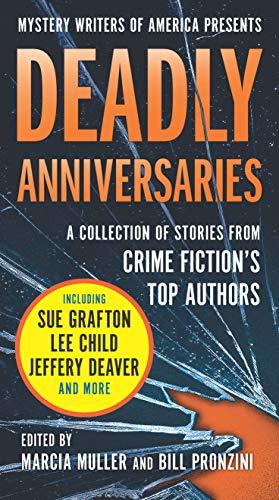
I am pleased to share with you something from another of my favorite newsstand publications, Mystery Scene. The great Jon Breen included Do No Harm in an article about recent legal thrillers; a lovely color reproduction of the cover of this latest Heller novel accompanied it.
“Max Allan Collins’s excellent series about Zelig-like private eye Nate Heller fictionalizes major crimes of the past century. Occasionally, Heller drops in on classic trials, perhaps most notably in Damned in Paradise(1996), featuring a complexly characterized Clarence Darrow appearing for the defense in a 1932 Honolulu rape case. The latest in the series, Do No Harm (Forge), considers the murder of Marilyn Sheppard for which her husband Dr. Sam Sheppard, a Cleveland osteopath, was tried and convicted in 1954 and retried in 1966, this time with famed advocate F. Lee Bailey heading the defense. Both trails are visited in a total of about a dozen pages, the first summarized to Heller by newspaper columnist Flo Kilgore (a transparent pseudonym for Dorothy Kilgallen), the second viewed by Heller and including some well-selected quotes from Bailey’s cross-examinations. All the real people in the cast – Bailey, Kilgore/Kilgallen, Erle Stanley Gardner, Eliot Ness, and especially Sam Sheppard himself – come to life as convincing fictional characters. As usual, Collins’ concluding author’s note provides a bibliographic essay on his sources to make the fact/fiction demarcation clear.”Getting back to short fiction, a story that I consider one of my best – “Amazing Grace” – appears in the MWA anthology, Deadly Anniversaries. It’s on sale now in e-book form for under two bucks, right here.
Here is an absolutely stellar Come Spy With Me review at Bookgasm.
Here’s a mixed but smart review, mostly favorable, of Skim Deep. But for the last effin time, it’s Nolan, not Frank Nolan. He has never been Frank Nolan. Stop it already.
Finally, here’s a nice if belated (but appreciated) UK review of Girl Most Likely.
M.A.C.
February 16, 2021
In This Exciting Issue!
One of the small pleasures denied me during this pandemic, where Barb and I have been largely sheltering in place for almost a year now, is going to Barnes & Noble and Books-a-Million to check out the new magazines.
But magazines have been a stubbornly dying breed for some time, and my favorites – most dealing with B-movies – have been hit hard. A particularly tough loss to take comes as a double hit – the writer/editor/publisher behind VideoScope, Joe Kane, has died.
And with him has gone his wonderful magazine.
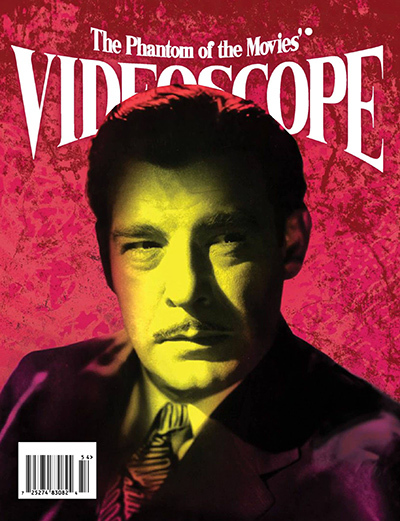
VideoScope was among the last of a handful of magazines combining reviews of what a prior dead magazine called psychotronic movies with news, articles and interviews. I never met Joe, but we exchanged many e-mails and I was an occasional contributor to the magazine. He was a consistent booster of my films and, when he was writing for the New York Daily News, reviewed both Mommy movies generously.
I looked forward to receiving VideoScope in the mail the way I used to (in my high school years) look forward to snagging my father’s gift subscription copy to Playboy before he got home from work. Of course Playboy – like my father – is gone now, but perhaps that magazine’s demise has to do not just with changing times, but the reality that certain magazines – yes, like the otherwise dissimilar VideoScope – were so much extensions of their creators/editors that they could not survive their absence. The fate awaiting Hustler, now that Larry Flynt is gone, is likely the same.
I dealt with a Flynt-like editor of the Hustler-like Climax magazine in Quarry’s Climax, the sexual content of which offended some readers – usually the same readers who weren’t offended by the violence. And I revisit aspects of that story in the forthcoming Quarry’s Blood. I liked Flynt’s Hustler, which had an outrageous sense of humor and a unique combination of blue-collar sensibility and left-wing politics (only “Asshole of the Month” could do a Tucker Carlson justice). The interviews and articles were often of interest as well (I will stop short of defending myself by saying, “I read Hustler for the articles,” even if it is sort of true – but I doubt I’ll be picking it up again).
Among the more respectable magazines I have looked forward to are two devoted to Old West history/pop culture, True West and Wild West. Both remain excellent and the former is the work of Stuart Rosebrook, a friend of mine who I’ve watched in recent years rise to the position of editor (the magazine’s publisher and creative guiding hand is the great artist/writer, Bob Boze Bell). Stuart Rosebrook’s screenwriter father Jeb wrote the classic “modern” western, Junior Bonner and much else (including The Waltons and The Yellow Rose on TV, The Black Hole feature film and The Gambler TV movies); when Stuart was living in Iowa City, he arranged for me to meet his visiting dad, which was an honor and a thrill.
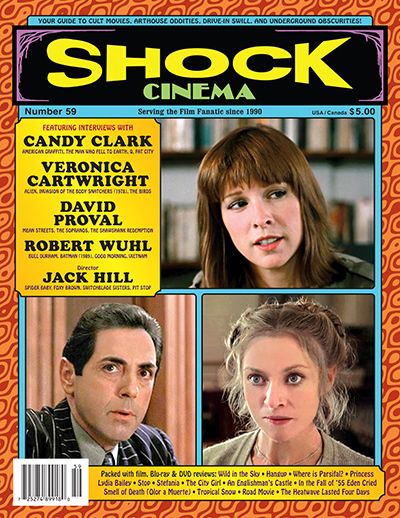
With VideoScope gone, only a few stalwart defenders of the psychotronic side of cinema remain. A standout is Steven Puchalski’s Shock Cinema, which combines in-depth interviews with actors and filmmakers with reviews of obscure movies, Blu-rays/DVDs, and books. It has the same kind of fannish yet professional touch as Joe Kane’s VideoScope but with its own distinctive spin. The current issue is typical, featuring incredible interviews with actors Candy Clark (American Graffitti), Veronica Cartwright (Alien), Robert Wuhl (Arli$$), and director Jack Hill (Switchblade Sisters). A similar survivor is Darryl Mazeski’s Screem, another newsstand survivor. Like Shock Cinema and the now-lamented VideoScope, Screem has a personal touch and its own look and feel.
A slicker classic cinema magazine that somehow endures is the UK’s Cinema Retro, with incredible in-depth articles, wonderful reviews, and contributions by my pal Raymond Benson. Every issue is a feast, and occasionally they do a special issue devoted to a single classic film, with the emphasis on the ‘60s and ‘70s.
But these baby-boomer delights are a dying breed, as are magazines themselves, I fear.
Among the first things I did when it became clear we’d be sheltering in place until a vaccine arrived (and we still are waiting, Barb and I, for our shots) was to subscribe to all of the above and a few other magazines. But the joy of going to the magazine section of a book store, to see if a new issue of a favorite periodical is on the stands, is among the small yet keenly felt losses of this pandemic.
Joe Kane, who called himself the Phantom of the Movies, is a loss particularly keenly felt. So are the many magazines we have all loved…and taken for granted.
* * *Here’s my introduction to the just-published IAMTW tie-in anthology, Turning the Tied. (Kindle link)
I also discussed tie-in writing in the forthcoming MWA, Lee Child-edited mystery writing handbook.
M.A.C.
February 9, 2021
The Busy Lane I Picked
I’m at one of those odd junctures where, because I write so much, I am bombarded by the demands of individual books ganging up on me, as needy as bunch of starving brats.
Look, I know it’s my fault, a combination of karma and my selfish desire to do a lot of different things and, along the way, maybe earning a decent living. My inclination, as an artist (I think that’s a fair way to put it, as long as I don’t add an “e” on the end) is to do one project at a time. Concentrate on one thing.
I mostly write novels, and I write them much as I read books – one at a time. I am not one of those strange, unfathomable people who read a number of books at once – they are like drunks changing channels on a runaway remote, as far as I’m concerned. This is one of the reasons why I don’t read much fiction – because the book I’m immersed in is the book I’m writing.
And you may have noticed that I’m always writing a book.
Almost always. I do take a week or two off between books, but I do other writing then – like short stories and articles – and catch up with the things I’ve neglected, like real life.
But fiction writing is a business, or rather a hobby or an art that has to be a business if you want to avoid a real job, a goal I have pursued since I quit my job sacking groceries in 1967. And as a business, the demands of publishing don’t care that I’m writing a book, particularly a book a given publisher isn’t, you know, publishing.
What am I talking about?
I am talking about having just finished Quarry’s Blood, and my incredibly fast editor, Charles Ardai of Hard Case Crime, read it in a couple of days and returned it with queries and minor rewrite requests, all reasonable and helpful. In the scheme of things, getting a freshly finished novel back with such immediacy is both unusual and wonderful. Everything is still fresh in my mind, and I can do the novel justice.
However. I am also dealing with the galley proofs of Antiques Carry On. Due simultaneously are the galley proofs of Live Fast, Spy Hard (John Sand #2), and the galley proofs for the short story collection, Suspense – His and Hers by Barb and me. In addition to the aforementioned Antiques Carry On galleys, our new publisher for that series quite reasonably wants a questionnaire about the book and its authors filled out, and an essay about the book written for their customers.
Galley proofs require a close read, looking for mistakes on the publisher’s end (typos) and mistakes on the author’s (continuity errors and general clean-up of writing problems, like repeating a word too many times on a page). It’s a time-consuming prospect – an Antiques book or the John Sand would take a day or two each.
Even worse is when a copy-edited manuscript comes in (the step before galley proofs), at least when a copy editor has overstepped his or her job description. This happens a lot, in my experience. Why a serial killer in one of my books hasn’t singled out copy editors for attention yet is a greater mystery than I have ever concocted.
Am I complaining? Well, of course I am, but not really. I am complaining more about my inability to do more than one thing at once. But I am improving. Right now, it’s my privilege and pleasure to be working with someone I admire and, even better, really like – Dave Thomas, SCTV star, among much else. Dave is working on the first draft of a book we’ve been working on for over a year, a project I am very proud of and am anxious to discuss here in more depth, when the time is right.
Dave, probably because of his incredible improv background, likes to run things by me and we talk and kick things around, and it’s really just great fun. I seem to have no problem stepping out of, say, Quarry’s Blood to talk about and explore the options and possibilities for our novel together in a plotting session.
But one of the things that’s become clear to me, when I’ve had such disparate projects as the Dave Thomas one, Quarry, Antiques and John Sand spinning in my brain like a noir dream sequence, is that I’ve come to understand better why I can’t expect every reader of mine to like or even understand every facet of my imagination and interests.
Some of you may recall a reader, irritated by one of my relatively rare excursions into politics, insisting that I should “pick a lane.” I responded that I am left of center in my politics, but close enough to the middle that both lanes of traffic have an equal swipe at me. I also mentioned that I feel nuance is a positive, not a negative.
I have, obviously, picked a lane in my writing – mystery/crime, but even that is really two genres, and of course horror is part of it, as the current Reincarnal & Other Dark Tales demonstrates. But it’s clear to me, at this ripe old age, that I would have been more popular and successful as a fiction writer if I had been more narrow in focus.
The thing is, I am driven not so much by genre considerations as I am by ideas. Ideas have driven every novel writing choice I’ve made. Quarry was a hitman who had to solve the murder he committed. Road to Perdition was a take on John Woo and other Asian influences my then very young son and I were taking in. Mommy was a reversal of The Bad Seed’s premise. Eliot Ness, both novel and non-fiction, was looking for the man behind the myth, and his real cases. Black Hats was old Wyatt Earp meets young Al Capone. USS Powderkeg was a way to talk about my father’s experiences with an all-black crew in the Pacific during the Second World War. Krista and Keith Larson was an American take on Nordic noir and a step away from hardboiled genre types. Ms. Tree was Velda marrying Mike Hammer and Mike getting killed on their honeymoon. Antiques was a young woman using antiquing (and amateur sleuthing) as a positive way to relate to her eccentric mother. Supreme Justice was somebody killing Supreme Court justices to change the balance of the court. John Sand is the spy that James Bond was based on. And on and on.
Ideas.
And the need to execute these ideas in a way that is appropriate to the material is the goal – effective storytelling, interesting to me. Fiction writers should write the novels they want to read themselves. Their first audience is themselves – and my readers are invited in, welcomed in, but don’t always share my interests and enthusiasms.
So I get it if Girl Can’t Help It doesn’t please somebody who is really into Quarry and Nolan. I wholly understand if someone into the Antiques series is horrified beyond words at my writing Mike Hammer novels.
But it is, frankly, hurtful when a reader feels betrayed by a choice I’ve made, and attacks a work that isn’t on their wave length as if I have failed them or am “phoning it in” or doing inferior work simply because it’s not to their taste.
And here in the last phase of my career – which I hope will be another twenty years, don’t get me wrong – I am interested in getting as many of the stories I want to tell fucking told. I am (as perhaps being the co-author of a series of cozy mysteries about antiquing might indicate) a collector. I am of perhaps the first generation of mystery writers who were fans first, and became writers.
So what I am doing, in 2021 and beyond, is collecting my own books. In a way, I am my own biggest fan, but also my harshest critic. A creative person needs to be an unlikely combination of self-confidence and self-doubt, and I certainly qualify.
* * *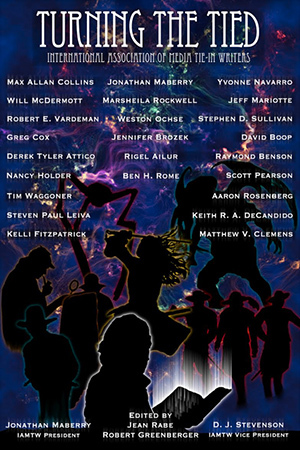
Matt Clemens and I have contributed a Sherlock Holmes short story to an exciting new collection by top tie-in writers. Read about it here.
J. Kingston Pierce’s Rap Sheet is always worth reading. Some interesting news about me is buried in his latest installment.
Finally, Mike Hammer: The Night I Died graphic novel from Titan is one of seven recommended graphic novels here.
M.A.C.
February 2, 2021
Book Give-Away, Noir Alley Clips, and a Current Interview

This week we have fifteen copies of the beautiful Wolfpack trade paperback edition of Reincarnal & Other Dark Tales to give away. I’ve written about this book here before, but I only now have physical copies in hand.
As usual, you need to write me at macphilms@hotmail.com, and (IMPORTANT) include snail-mail address, even if you already entered previous giveaways here and done so. You agree to write a review at Amazon and/or elsewhere for the book. Should you hate Reincarnal, you are absolved from this duty. Otherwise, whether a rave or a mixed review, have at it.
If you miss out on the giveaway, I hope you’ll order it anyway, either on Kindle or this very cool trade paperback, which is a rather massive 330-some pages. It collects virtually all of my horror short stories, including two radio plays written for Fangoria’s Dreadtime Stories.
Be forewarned (or enticed, as the case may be) that many of the stories in Reincarnal (as the title may indicate) have a strong sexual element. This has to do with many of them originally having been published in erotic horror anthologies, back in the day when such stalwarts as Marty Greenberg, Jeff Gelb and Ed Gorman were turning out wonderful “theme” anthologies of original stories.
As I said here before, horror is a strong element of my fiction – you can see it in the Mommy novels (available from Wolfpack), many of the Quarry novels (The Wrong Quarry), a number of Hellers (Angel in Black), Eliot Ness (Butcher’s Dozen) and novels by Barb and me (Regeneration). Even the recent non-fiction work, Eliot Ness and the Mad Butcher (by A. Brad Schwartz and myself) qualifies as horror-tinged. The only horror tales not collected in Reincarnal can be found in the Wolfpack collections Murderlized (gathering collaborative stories by Matt Clemens and me), Blue Christmas (holiday horror and dark suspense), and Murder – His and Hers (stories by Barb and me).
While I am first and foremost a novelist, I do enjoy writing short stories and it’s long been an ambition to see collections of my shorter fiction, like Reincarnal, give those stories a certain permanence.
* * *If you missed my second guest shot with Eddie Muller on Noir Alley, here is the intro and the outro for Born to Kill, a great crime movie you should see (the TCM streaming service has it right now).
* * *Publisher’s Weekly has a great article by Lenny Picker about Hard Case Crime. I can’t share it with you, because PW requires you to subscribe for the link to go through.
I was interviewed for the PW article on HCC, and a grand total of one paragraph was used (in part) in that article. So, since that interview is very up-to-date as to what I’m up to, I’ll share it here:
What led you to have some of your books published by Hard Case Crime? In other words, what makes a Collins book a better fit for HCC?When editor/publisher Charles Ardai began Hard Case Crime, he featured a number of reprints among the originals, from the classic likes of Erle Stanley Gardner and Lawrence Block. He approached me about reprinting the second Nolan novel, Blood Money, and I suggested he reprint both it and the first in the series, Bait Money, under one cover, which he did, as Two for the Money. Later he approached me about doing another reprint and I offered instead to write an original. It was obvious to me Charles and his partner Max Phillips had a love and feel for classic hardboiled fiction and represented a home for what I most like to write in a market not terribly conducive to that.
Another fact was the retro packaging, the covers that were not only fully illustrative in the fashion of ’50s and ’60s paperback suspense novels, but depicted beautiful femme fatales and handsome tough guys, in a fashion that had become essentially forbidden due to politically correct restraints at other publishers. HCC has a way of saying, “We’re retro, not Neanderthals. We have our tongue slightly in cheek as we celebrate a form of American mystery fiction pioneered by such greats as Raymond Chandler and Dashiell Hammett.”
What makes them different from other publishers/imprints?
They go their own way and are motivated by a love for the noir genre, taking risks with new talent and respect older talent. Charles Ardai encourages me to write what I want to write. I’m at a point in my career and, frankly, at an age where being able to write what I want means more than financial considerations, an approach that can pay off better than a more market-driven, cynical one.
For example, the first original I did for HCC was a return to my Quarry series, which had become a cult favorite after its initial four-book run in the mid-’70s and a one-shot comeback ten years later. I’d always wanted to complete the series and The Last Quarry was intended to be the final book about my hitman character…the first contract killer to “star” in a book series. The Last Quarry was popular and widely well-reviewed. Charles said, “Too bad you’ve written the last book in the series.” And I said, “How about I write, The First Quarry?” Since then another dozen or so have followed. An award-winning short film I wrote led to a Quarry feature film (The Last Lullaby), and a few years ago HBO/Cinemax did a Quarry TV series.
What led you to revive Nolan last month?
Charles has been after me to do that dating back to Two for the Money. I resisted, feeling my novel Spree was the proper ending to the series. But he said he’d bring the early books back out if I did a coda to the series, which I have — the current Skim Deep. Now I’m writing a coda to The Last Quarry called Quarry’s Blood. My hitman is 68 years old in the novel, which is younger than me.
How hard was it to return to the character after so many years?
Not at all. I spent almost two years, when I was at the University of Iowa Writers Workshop in the late ’60s, writing that novel. My instructor was Richard Yates, the great mainstream novelist. I also studied with Walter Tevis, whose reputation is getting a boost from The Queen’s Gambit mini-series. So I spent a lot of time with Nolan and his young sidekick Jon, and then there were the other six novels and several versions of a Nolan screenplay I wrote a while back…unproduced as yet, but it got optioned. A movie is brewing now combining elements of several of the novels.
How was writing him different?
He was an old man of 48 when I conceived him at age 20. Now he’s 55 and really something of an old man, so my perspective on him has shifted.
Are there other characters that you’re planning on reviving?
I get requests to do another Mallory, but that character was based on me, which doesn’t interest me. My recent Krista Larson series I hope to keep going, and when the political world settles down, if it ever does, I might do another Reeder & Rogers novel with Matt Clemens, who I’m writing the James Bond-ish “John Sand” novels with now for Wolfpack. My wife Barb and I are continuing the long-running Antiques series we write together as Barbara Allan, with Severn now.
The biggest thing will be taking Nathan Heller to HCC. I consider the Heller novels – which as you know are traditional tough private eye novels dealing with major crimes of the Twentieth Century – my best work, my signature work. But I don’t spend all my time looking backward. I’m working on two projects for Neo-Text, one a ’40s female private eye, Fancy Anders, who solves mysteries involving an aircraft plant, a movie studio, and the Hollywood Canteen. The other is a science-fiction-tinged noir collaborating with SCTV star Dave Thomas, who was a writer/producer on Blacklist and Bones, for which I wrote a tie-in novel.
I should note that HCC has been a supporter of my work building up the legacy of my friend and mentor, Mickey Spillane. We’ve done several books at HCC, and something like fourteen Mike Hammer novels at HCC’s parent company, Titan. These all reflect my completing unfinished manuscripts from Mickey’s files, something he asked me to do shortly before his passing in 2006. Next year is the 75th anniversary of Mike Hammer, and I’ll be doing a biography of him with James Traylor for Otto Penzler at Mysterious Press. It’s people like Charles and Otto who nurture and keep the hardboiled genre alive in the face of changing times.
What would you most want article readers to know about HCC?
HCC is a boutique publisher that cares about books, readers, and authors. I am extremely grateful to them for letting pursue my work my way.
* * *A reader in this You Tube piece recommends five HCC titles to represent that publisher’s output, and The First Quarry is one of them!
And, finally, this fantastic review from the UK of the current Mike Hammer, Masquerade for Murder.
M.A.C.
January 26, 2021
Cover Story
I had not been given an advance look at the Noir Alley episode this weekend that had me guest-presenting with Eddie Muller the great film noir, Born to Kill (1947) from the James Gunn novel, Deadly Is the Female. During the shoot, Eddie and I had talked about both the film and the book for maybe forty minutes, and the TCM editors honed it down beautifully. I am very pleased, and if it turns up on You Tube, I’ll share it here.
God, I love it when I don’t stink up the place!
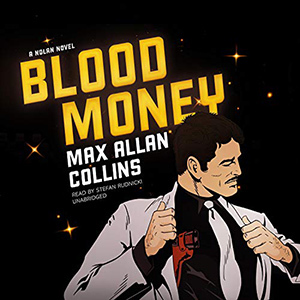
Audible
Skim Deep has been getting some lovely notices, I am pleased to say, including great Amazon reviews, and readers seem to be pleased either to see Nolan again or meet him for the first time.
But due out a week from today is the first-ever audio book of Blood Money, the second Nolan novel, read by the amazing Stefan Rudnicki. As you may know, Hard Case Crime is bringing out a new trade paperback edition of Two for the Money, collecting the first two Nolan novels – Bait Money and, again, Blood Money – on April 20.
The Edgar nominations are out, and Eliot Ness and the Butcher did not receive a Best Fact Crime nom, just as Scarface and the Untouchable did not in its year. It’s frustrating that this major work – I consider these two books joined at the hip – has not been better recognized; but I am confident that what my co-author, A. Brad Schwartz, and I accomplished will have a lasting place in true-crime literature.
Both Reincarnal & Other Dark Tales and Shoot the Moon (And More) are available in trade paperback(and of course Kindle) from Wolfpack. I talked about Reincarnal last week and spoke of my pleasure in having my short horror fiction collected in one place. I’m excited to see Shoot the Moon published as a novel and not as part of a collection. Originally it was featured in the now out-of-print Early Crimes, and the two short stories from that collection are still included, but moved to the back of the book as a bonus feature.
Shoot the Moon is a novel written fairly early in my career, but after Bait Money, Blood Money, No Cure for Death, The Baby Blue Rip-off and Quarry. So it’s not an early work in the sense of being formative or from my college days. The two short stories that serve as a bonus are, in fact, from my community college days, although one of them (“Public Servant”) was considered good enough years later to be included in a Lawrence Block-edited anthology (Opening Shots).
As I’ve mentioned earlier, Shoot the Moon is to the Donald E. Westlake comic crime novels as Bait Money is to the Richard Stark un-comic crime novels. My debt to Don Westlake, as an inspiration and mentor, is one I can never adequately repay.


My son Nate encourages me to share behind-the-scenes stories and such about the writing life. So here I go….
Wolfpack is a very interesting outfit, because its publisher, Mike Bray, is something of a visionary, and its editor-in-chief Paul Bishop is a first-rate novelist himself who approaches publishing with an empathy and feel for his fellow writers.
I have been particularly pleased with the covers that have come out of Wolfpack, and yet a couple of problems turned up recently. As an example of the rampant political correctness that all creative people suffer these days, the cover of Reincarnal – which I love – was rejected for use in ads by Amazon. Fortunately, I’m told, ads for Facebook with that cover are still possible.
Apparently Reincarnal having a knife on its cover is the problem. I’ve run into this kind of thing before at several publishers, who haven’t wanted a gun on their covers. In one case, a publisher doing serial killer books – where the editor had me add a violent opening scene – did not allow guns or knives on their covers. Hey, I’m all for keeping guns off the floor of the House of Representatives and Senate – none of those people should be allowed around sharp objects – but on the covers of thrillers, horror novels and noir?
Who are we protecting with this prissy attitude, anyway?
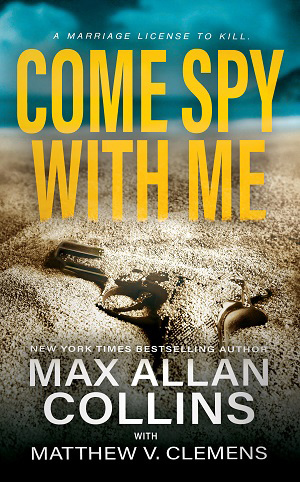
Conversely, the wonderful cover of Come Spy With Me has taken some heat for being too classy, too subtle. And it does have a gun on it! That gun is on a beach covered in sand, which anyone whose favorite word isn’t “Duh!” will tell you was meant to make you think of the protagonist, John Sand. It’s possible we’ll eventually do a second cover for that title, when the third Sand novel, To Live and Spy in Berlin, emerges – a book Matt Clemens and I are plotting, having delivered book two, Live Fast, Spy Hard recently.
Wolfpack’s bread-and-butter has been what I used to hear called “boy books” by editors both male and female. “Boy books” are westerns, techno-thrillers, male-lead thrillers, private eye novels and noir (the latter will come as a surprise to Christa Faust and Megan Abbott). Westerns and men’s adventure-type novels, including spy stuff, do very well at Wolfpack, and while my work is at least vaguely in the “boy book” vein, I am part of the publisher’s effort to expand into new publishing realms. And I salute them for that.
“How can I help?” I hear you saying.
You can buy Reincarnal, Shoot the Moon, and Come Spy With Me for a start, and all the other titles of mine Wolfpack has been good enough to foist upon you lucky people.
At fear of kissing up (well, I’m not that afraid), I will say that Wolfpack, Hard Case Crime, Titan and the emerging Neo-Text are publishers who are allowing me to explore the genres and characters I care about, both old and new, and God bless them for it. Every one of them has invested their faith in me and my work in a way that goes well beyond the standard publishing approach of, “Well, we’ll throw one or two of your titles out there and see how they do.”
Publishers, notoriously, have laid all the blame on the writer for the lack of success of a book. We writers are where the buck stops, and you might say, “Of course you are!” But the truth is publishers are not in the book-selling business, they are in the cover-selling business. Hey, if my books aren’t packaged correctly, it’s not my effing fault.
Now, I have to cop to having loved some covers that didn’t work in the marketplace, and having hated some that did. But it’s not my job to package the books. I am busy writing them. I am hard at work making Wheaties. What athlete goes on the box isn’t my choice or my fault, which means I can’t take full credit for how many boxes of Wheaties fly off the shelves.
Publishers usually ask for a writer’s input into the covers, and then ignore that input, often for good reason. Hard Case Crime sends me the cover before I’ve even written the book, so I can work the scene into the narrative, like the old pulp writers used to – I get a perverse pleasure out of that. Thomas & Mercer gave me a lot of input into the covers, and I love the results. Those books continue to sell briskly.
But here is my dream. An editor has a series that has received glowing reviews, a series that said editor considers first-rate, though with a small but dedicated reader base, if not enough to justify publishing any more books in that series. Rather than drop that series like something icky, why not consider a re-packaging approach, and take a hard look at the marketing that has (or hasn’t) gone into it, and give that series a book or two more, with a new cover and new marketing approach, before deciding its ultimate fate?
That never happens.
Keeping Nate Heller alive through five major publishing houses, with a fifth coming, over almost fifty years is a small miracle – no, a big miracle, speaking to my own stubbornness and my only-child inability to be told “no.”
And yet. Here is Nolan back in print. Here is Quarry not only back in print but with me writing, right now, the tenth new book (Quarry’s Blood) in a series started back up again in 2006 when the damned thing had been declared dead in 1976.
* * *J. Kingston Pierce’s The Rap Sheet, hands down the best mystery site on the web, has an edition of his entertaining column-within-a-column “Bullet Points” that has a nice paragraph about the book I’m writing now (Quarry’s Blood) and Heller.
January 21, 2021
Noir Alley
I will be on Noir Alley on TCM with Eddie Muller for the second time, introducing and discussing one of my favorite noir films, Born to Kill!
TIMES — ALL JANUARY 24:
12 AM Eastern (that’s midnight Saturday)
9 AM Central
7 AM Pacific
It’s a great crime movie from a terrific novel — don’t miss it!
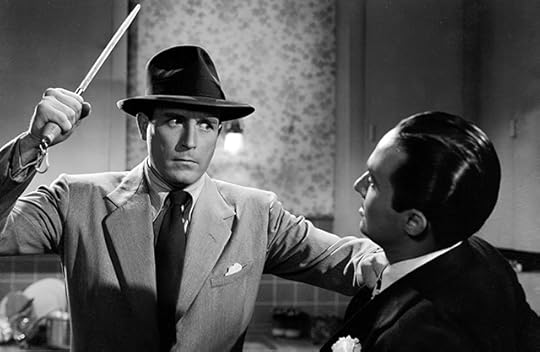
January 19, 2021
New Horror and Dark Suspense Antho from Wolfpack

E-Book:

In about a week, my latest Wolfpack release – Reincarnal & Other Dark Tales – will be available on Kindle, and shortly thereafter as a physical book.
When I have copies of the trade paperback, I will announce a book giveaway here. For those that haven’t noticed, this update/blog has a new post every Tuesday morning. [10 Eastern/9 Central unless I mess something up. –Nate] So check in – they go fast.
Obviously, Wolfpack has provided me with another outstanding cover. I continue to be delighted by what they come up with. I realize some of you may be overwhelmed by how much of my material Wolfpack has unleashed upon an unsuspecting world pretty much all at once. Publisher Mike Bray and editor Paul Bishop were good enough to take on virtually all of my remaining backlist, as those who come here regularly know. Nine of these books are novels, but the others are anthologies. Of those anthologies, only three (including a forthcoming one by Barb and me, Suspense – His and Hers) are new collections…new books.
Reincarnal is one of them.
It’s a special one for me, because it collects virtually all of my horror short stories. In addition, the book includes two radio plays that I wrote for Fangoria’s Dreadtime Stories: “House of Blood” and “Mercy.” I adapted a number of the yarns in the collection for Dreadtime Stories, but the two radio plays were original to the series.
While I’ve spent most of my career writing suspense and crime fiction, the horror genre has been an interest since childhood, undoubtedly having to do with watching old monster movies on TV. In Reincarnal, you meet the big three: Frankenstein’s monster, a werewolf, and more than one vampire.
Some of the stories are more in a “dark suspense” vein, though the majority have a supernatural element. And they have another element that may either please or not please you: this is definitely a “parental advisory” type book. Several stories were originally written for the famous Hot Blood and Shock Rock series, whose co-editor Jeff Gelb was my co-editor on Flesh and Blood. The format of those anthologies was to combine horror with an erotic element.
I mention this because – much to my surprise – in recent years some readers are offended by sexual content, and many of you are undoubtedly saying, “Boy, did they sign up with the wrong writer.” In re-reading the stories, I realized that changing times and attitudes are reflected therein, but I made no edits to bring them up to date. They were written over a thirty-year period and, like Popeye, yam what they yam.
But also in re-reading the stories I discovered that some of these dark tales are among my best work. I would be hard-pressed to come up with a better story of mine than “Traces of Red,” for example. “Reincarnal,” the lead story, was much praised at the time of its original publication, and I adapted it into a screenplay. That project still rears its head now and then. “Interstate 666″ was written originally as a screenplay, and the story herein is actually a condensed version. It came very close to being made as a TV pilot (one iteration involving Rob Zombie!).
Both radio plays in the new collection were conceived in hopes of movie production and they too are not yet off the table in that regard. Those stories are collected in audio anthologies available at Amazon and elsewhere. Producer Carl Amari did a great job on them.
My interest in horror should come as no surprise to my regular readers, even though they may missed the stories collected in Reincarnal when originally published. Such novels of mine as Butcher’s Dozen, Angel in Black, and What Doesn’t Kill Her, as well as the two J.C. Harrow novels by Matt Clemens and me, are in part horror novels. So is Regeneration by Barb and me (a new edition is coming from Wolfpack).
Speaking of which, let me get back to Wolfpack. You supporting my efforts there by ordering Reincarnal & Other Dark Tales and the John Sand novel, Come Spy With Me, paves the way for me to do new novels in various series that have run their course at other publishers. When fans ask a writer, are you ever going to do another novel about such-and-such a favorite character, the true answer is: it’s not up to the authors. We need publishers who believe in us, and frankly most publishers want the next big thing, not the last modestly successful thing.
* * *We lost Parnell Hall recently, and the parade of hurtful losses to the mystery genre continues. The great John Lutz of Single White Female fame is gone.

This from Janet Rudolph:
John Lutz: 1939-2021.I was lucky to know John Lutz over the years. John wrote over 50 novels of political suspense, private eye novels, urban suspense, humor, occult, caper, police procedural, espionage, historical, futuristic, amateur sleuth, thriller — just about every mystery sub-genre. He also wrote over 200 short stories and articles. John was a past president of both Mystery Writers of America and Private Eye Writers of America. Among his awards were the MWA Edgar, the PWA Shamus, The Trophee 813 Award for best mystery short story collection translated into the French language, the PWA Life Achievement Award, and the Short Mystery Fiction Society’s Golden Derringer Lifetime Achievement Award. And, he was a kind, supportive, and generous man. He’ll be missed.
I knew John well, and Barb and I know his wonderful wife Barbara, too. John was a terrific writer and also displayed a dry wit second to none. For many years, John was a welcome, low-key presence at Bouchercon, one of those friends I saw almost exclusively in that manner. He was shy and modest, but that sense of humor came through, or I should say sneaked up on you.
This one hurts.
* * *This mind-bogglingly wonderful review of Skim Deep is at Book Reporter. Please feast your eyes upon it.
M.A.C.
January 12, 2021
Fate of the Union and More Queen’s Gambit
As many of you know, my friend and longtime collaborator, Matthew V. Clemens, and I wrote a trilogy of political thrillers a few years ago, with the three branches of our government represented by individual novels. They are Supreme Justice (the Supreme Court), Fate of the Union (Congress), and Executive Order (the Presidency).
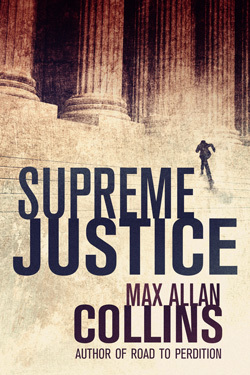
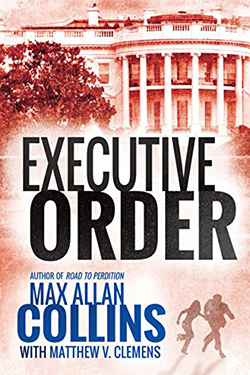
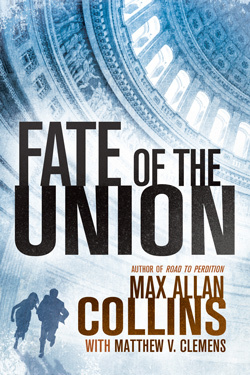
As it happens – not really as part of any plan – all three deal with threats from within, essentially domestic terrorism. Somewhat chillingly, the second novel – Fate of the Union, published in 2015, posited a run for the Presidency by a billionaire populist as well as an attack on the United States Capitol building.
After the events of last Wednesday, January 6, occurred, I asked Matt, “Shall we sue Trump for plagiarizing us on Fate of the Union?” His response: “Can we? Can we please?”
Last week I neglected to announce that all three Reeder & Rogers titles are on sale on Kindle until the end of this month (January). Supreme Justice and Fate of the Union are $1.99 and Executive Order is 99 cents.
* * *I’ve had many nice comments about my update last week, in which I talked about (among other things) my time at the Writers Workshop in Iowa City with Walter Tevis as my instructor. That included my thoughts on the wonderful Netflix mini-series based on his 1983 novel, The Queen’s Gambit.
Barb and I enjoyed that mini-series very much – we watched it twice – and I found myself compelled to take the novel off the shelf (it, and Walter Tevis’s other books, are in my office in one of two bookcases of honor) to read it for the first time. Years ago I had, wrongly, set it aside because of its chess theme, thinking that I needed to be intimate with the game to enjoy the novel.
I was stunned to discover how incredibly faithful the mini-series was to its source, perhaps the most faithful film adaptation of a novel I’ve encountered in years. Oh, they are out there – for example, you can follow The Maltese Falcon in the book while you watch the John Huston film, skipping only the scenes (and they are few) that didn’t make it into the movie.
The Queen’s Gambit, the mini-series, not only replicates almost all of the dialogue from the novel, it endeavors to turn interior monologue into speech and pays close attention to descriptions of clothing and particularly setting.
When Beth enters fellow chess player Benny’s basement apartment in New York, Tevis tells us, “There were plastic bags of garbage in the entryway,” and details the pump Beth must pedal with her foot to inflate a rubber mattress. Earlier, when Beth spends the night with a college boy and wakens to find herself alone in a post-party house, the note to her on the refrigerator is held by “a magnet in the shape of Mickey Mouse’s head.” And that’s what is depicted in the mini-series.
Countless details, including mannerisms of Beth’s chess opponents, are recounted, like a young man who brushes back his hair. Someone – or many someones – loved this book! It’s astounding.
Now, differences do crop up, though mostly it’s expansion of scenes. The major ones have to do with Beth’s mentally disturbed mother, a boy she loves who the mini makes gay, and a somewhat opened-up last few chapters, with an almost Capra-esque long-distance-call reunion of many of Beth’s chess-world friends when she can use some help with the big match. The scene is in the book, but only involves Benny and a couple of chess experts, not a reunion of characters – which is a good change, because it shows that this lonely girl has friends and needs friends. The gay (bisexual?) sort of love interest shows up in Moscow in the final section, also to be supportive, and it’s a good change. A less good one is having Beth’s black friend, Jolene, seek Beth out as an adult when the book shows our troubled protagonist reaching out to that old friend. Tevis shows Beth struggling to help herself and not just being rescued out of the blue.
These differences are well within the rights of the adaptors, and I generally feel that a film only has a responsibility to be faithful to the spirit of its source. I was fine with most of the liberties taken with Road to Perdition (and any writer who cashes the check should shut the hell up, anyway).
But seeing filmmakers who view the text as, if not sacred, something to be plumbed for inspiration and guidance, well…that is as refreshing as it is unusual.
Now, I’m going to shift gears but stay on the subject of Walter Tevis and The Queen’s Gambit.
If you’ve followed these updates or read interviews with me, you may be aware that I read little fiction. The reasons are numerous, but among them is avoiding being influenced by style. I’m enough of a natural mimic that I can get myself in trouble.
A major reason is that a book I am writing is, in a very real way, a book I am reading. And I’ve never been one to read two books at a time, going back and forth between them. Not my way. So, immersed in the narrative I’ve been trying to get down on paper, I avoid other people’s prose narratives.
Now, that does not include reading non-fiction, even biographies. Nor does it include listening to a book in the car on a trip, back when we took trips in cars. Remember that? And I watch a lot of movies and TV in the evenings, winding down.
But there’s another difficulty I have reading fiction. I don’t really believe in rules of fiction writing – to me, storytelling is mostly strategy. For example, is this a story better told in third-person or first-person? Where in the story should I begin? Should I end a dialogue scene when I get to a snappy, memorable line, or let it play out? And a million other things, or anyway thousands.
I have been writing professionally since 1971, but I was trying to write professionally starting in 1961 and worked at a newspaper in the summers of ‘66 and ‘67. So I’ve been at this a while, and though I studied at the Writers Workshop, and benefitted from it, I learned early on that you can’t be taught to write by anybody but yourself. You can get tips from a pro like me, but to learn to write you must do things: you read and you write. You read because you love it and, later, you read analytically; and you write by trial-by-error.
So in these many years, I have come up with those thousands of strategies that have become, in a way, my rules. Not your rules, not anybody else’s rules; but mine. Some of my approach has bled over into collaborators like Barbara Collins and Matthew Clemens, but they have developed their own rules/strategies, too…as well they should.
Okay, I said above that part of learning to be a writer is reading books. And for the years leading up to becoming a professional novelist, I did. So why don’t I read much fiction any more? (I do read some – mostly the people I read before becoming a pro, however, like Hammett, Chandler, Stout, Spillane, Christie, etc.).
Which brings me to The Queen’s Gambit again. Tevis is a wonderful writer, and I learned things from him then (and now), although probably more from The Hustler than his classroom teaching. I was struck by how beautifully Queen’s Gambit is written and came upon passages that I stopped and re-read aloud.
Not often.
A book that has you doing that all the time is a book by an effing show-off. Some highly respected writers in my genre, much more respected than me, are dedicated to making themselves and their readers feel important. Well, I already feel important enough, so to hell with that, and anyway I’m here to try to tell you a good story. Don Westlake told me, “Good writing is invisible.”
Tevis writes simply but is not afraid to use a word you may not know. He is clear and he is precise. I have been criticized by blog-type reviewers and even mainstream reviewers, as well as an editor (former editor), for writing about clothing and setting. Tevis does both and gives you not only a sense of place, but by doing so a sense of who those characters are. He wrote these detailed descriptions so thoroughly and well that they made it into the mini-series that everybody loves.
So I felt validated by that.
But I also stumbled on a writing strategy of his that began to bother me. He uses the “There is” and “It was” construction often. I find that passive, even lazy. It’s something that, in recent years, I’ve tried to avoid (though I didn’t in this sentence).
When Tevis would break one of my “rules,” it stopped me and I would find myself rewriting him, like Beth Harmon looking at the chess board on her ceiling and moving pieces around, replaying a famous game and looking for errors. It broke the spell.
Don’t get me wrong. I loved the novel. Tevis is a great writer and having books like The Hustler and The Queen’s Gambit on my list of credits would be a dream come true. But he had his strategies and I have mine, and as much as I enjoyed reading The Queen’s Gambit, it demonstrates why I rarely read fiction.
But please, please, everybody out there (both of you) – keeping reading stories. It’s what separates us from the apes.
That and opposable thumbs.
* * *This is a fabulous review of Skim Deep, and I swear I didn’t write it myself.
I get mentioned on the great podcast Paperback Warrior again, but run into The Fanboy Gambit – the reader who won’t read the new book till he’s read all the others in the series!
M.A.C.



